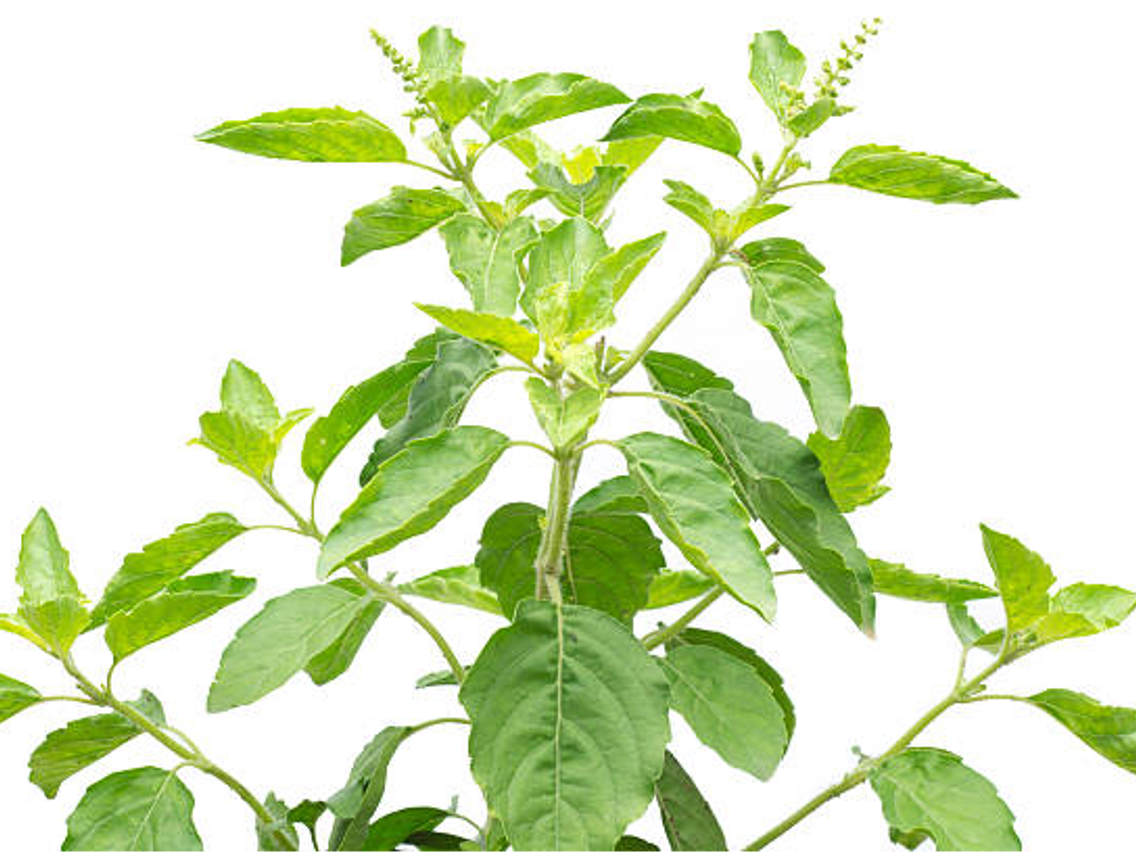Tulsi - Holy Basil

Common Names: Tulsi, Holy Basil, Sacred Basil, Ocimum sanctum, Ocimum tenuiflorum, Tulasi, Indian Basil, Queen of Herbs, Tulsí, Tulisi, Basalka krátkolistá
Latin Name: Ocimum sanctum (Ocimum tenuiflorum)
Origin: Africa, Asia, Australia, Europe, South America
Short Introduction
Besides thriving in the garden—ideally planted alongside tomatoes and cucumbers—holy basil also flourishes in window boxes, on balconies, or indoors in pots, provided it receives plenty of light and warmth.
Sow seeds sparsely and gently press them in with your finger. Water regularly. Within just three weeks, you’ll see vigorous seedlings. Holy basil does not tolerate frost, so be sure to plant outdoors only after the risk of late cold has passed.
Detailed Description
Holy basil, a plant dedicated to the god Vishnu in traditional Hindu medicine, is widely used both in culinary arts and herbal medicine.
Botanical Information
Holy basil is an upright, highly branched subshrub, typically reaching a height of 30–60 cm (sometimes up to 75 cm), with hairy stems and simple, opposite leaves (shades of green to greenish-pink to pink) about 3 cm long, known for their strong fragrance. The seeds are small and reddish-black, and the fruits mature in winter.
Origin and Distribution
This aromatic plant belongs to the mint family (Lamiaceae) and originated in Eastern Europe, from where it spread worldwide as a cultivated species. The Ocimum genus contains about 50 species of subshrubs and herbs that grow in both tropical and temperate climates, producing fragrant volatile oils as well as other valuable phytochemicals.
Usage / Dosage
Holy basil offers a wide range of benefits. It is an effective diaphoretic (induces sweating) and helps reduce fever during most colds. It also combats flu and respiratory problems, including allergies (by lowering histamine levels), and is particularly useful combined with mint. Its properties include not only antiviral, antifungal, and anthelmintic actions, but also antibacterial and antiseptic effects (with topical recipes for superficial fungal infections described below). Growing holy basil at home also provides a natural repellent.
Holy basil supports the nervous system and can be used to relieve cramps. It has a therapeutic effect on coughs (encourages expectoration), headache, arthritis, rheumatic fever (in general), and heart problems. It stimulates the heart, purifies the blood, acts as an anti-inflammatory, and helps regulate blood pressure and glucose levels.
It also promotes appetite and gastrointestinal comfort. Holy basil exerts a pronounced antioxidant activity, helping to stimulate immunity, reduce stress, and increase physical strength and resilience.
In traditional Ayurvedic medicine, it is used as an essential oil to clear excess Kapha from the lungs and nasal passages, enhance prana, and sharpen the senses. Holy basil also helps reduce high Vata in the colon, improves absorption, strengthens nervous tissue, and enhances memory. It is consumed in beverages with honey for clarity of mind. It stimulates appetite and digestion—enhancing Agni. Holy basil is said to protect from radiation (from sunlight, X-rays, television, and computers). Overall, Ayurveda regards it as an herb of first and last resort.
In cosmetics, the ursolic acids in holy basil support collagen biosynthesis and help slow skin aging.
Contraindications:
It is important to note that prolonged use can burden the kidneys.
Storage tip: Dried holy basil loses its healing potency, so be sure to store it in a dry, dark place.
Not recommended during pregnancy, breastfeeding, or for young children.
Active Compounds
Some of the main constituents in tulsi are oleanolic, ursolic, and rosmarinic acids—all with antiviral properties that support the immune system.
Eugenol, carvacrol, and linalool are monoterpenoid phenol derivatives that inhibit bacterial growth, promote expectoration, and support digestion. Additionally, caryophyllene (a sesquiterpene) acts as an anti-inflammatory and anti-allergic compound. These constituents also influence COX-2 inhibitors (anti-inflammatory), so holy basil’s effects are similar to paracetamol and other pain-relieving compounds.
Traditional Dosage
A typical dose of pure holy basil is 250–1000 mg of powdered or loose herb for infusions. Fresh leaf juice can be applied externally for fungal skin infections.
For colds, drink the tea 5–6 times daily (Indian-style with Darjeeling, cloves, a few peppercorns, ginger, and Tulsi, steeped together; honey may be added).
